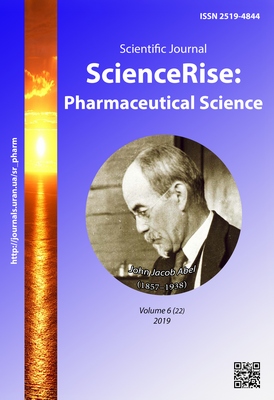The influence of lifestyle factors on constipation – should the pharmacist be aware of this?
DOI:
https://doi.org/10.15587/2519-4852.2019.188184Keywords:
constipation frequency, nutrition, physical activity, body mass indexAbstract
Aim of this study was to analyze the influence of lifestyle (nutrition and physical activity) on constipation and evaluate the respondents’ attitude to this disorder.
Methods. Pharmacy visitors who agreed to answer questions were included in the study. Data from respondents based on age (18-45 years old; 46-65 years old; above 65 years old) and body mass index (“normal,” “overweight,” “obese”) was analyzed. Nutrition and physical activity were analyzed for the purpose of identifying risk factors for constipation. Descriptive and comparative statistics were used – the respondents’ responses are presented in frequencies and percentages, Chi-square test was executed to measure association with knowledge, responses and gender, age, BMI.
Results. The study identified a 12.8 % constant constipation rate in the study group with no significant differences between genders, however more males had no constipation problem (50.5 % vs 39.9 %). The age and body mass index had association with constipation (p<0.05). The consumption of coffee and/or tea was not related to constipation in the study group, however, the respondents’ motionless lifestyle was related to constant and occasional constipation (75.0 % and 41.1 %, respectively) (p<0.05).
Conclusions. The consumption of carbohydrates, inadequate intake of fluids and motionless lifestyle were identified as risk factors for constipation in this study. Lifestyle modification recommendations might be included in the pharmacists’ consultation
References
- Peppas, G., Alexiou, V. G., Mourtzoukou, E., Falagas, M. E. (2008). Epidemiology of constipation in Europe and Oceania: a systematic review. BMC Gastroenterology, 8 (1). doi: http://doi.org/10.1186/1471-230x-8-5
- Cook, I. J., Talley, N. J., Benninga, M. A., Rao, S. S., Scott, S. M. (2009). Chronic constipation: overview and challenges. Neurogastroenterology & Motility, 21, 1–8. doi: http://doi.org/10.1111/j.1365-2982.2009.01399.x
- De Giorgio, R., Ruggeri, E., Stanghellini, V., Eusebi, L. H., Bazzoli, F., Chiarioni, G. (2015). Chronic constipation in the elderly: a primer for the gastroenterologist. BMC Gastroenterology, 15 (1). doi: http://doi.org/10.1186/s12876-015-0366-3
- Suares, N. C., Ford, A. C. (2011). Systematic review: the effects of fibre in the management of chronic idiopathic constipation. Alimentary Pharmacology & Therapeutics, 33 (8), 895–901. doi: http://doi.org/10.1111/j.1365-2036.2011.04602.x
- Wald, A., Scarpignato, C., Müeller- Lissner, S., Kamm, M. A., Hinkel, U., Helfrich, I. et. al. (2008). A multinational survey of prevalence and patterns of laxative use among adults with self-defined constipation. Alimentary Pharmacology and Therapeutics, 28, 917–930. doi: http://doi.org/10.1111/j.1365-2036.2008.03806.x
- Emmanuel, A., Mattace-Raso, F., Neri, M. C., Petersen, K.-U., Rey, E., Rogers, J. (2016). Constipation in older people: A consensus statement. International Journal of Clinical Practice, 71 (1), e12920. doi: http://doi.org/10.1111/ijcp.12920
- Quigley, E. M. M., Vandeplassche, L., Kerstens, R., Ausma, J. (2009). Clinical trial: the efficacy, impact on quality of life, and safety and tolerability of prucalopride in severe chronic constipation – a 12-week, randomized, double-blind, placebo-controlled study. Alimentary Pharmacology & Therapeutics, 29 (3), 315–328. doi: http://doi.org/10.1111/j.1365-2036.2008.03884.x
- Foxx-Orenstein, A. E., McNally, M. A., Odunsi, S. T. (2008). Update on constipation: One treatment does not fit all. Cleveland Clinic Journal of Medicine, 75 (11), 813–823. doi: http://doi.org/10.3949/ccjm.75.11.813
- Savica, R., Carlin, J. M., Grossardt, B. R., Bower, J. H., Ahlskog, J. E., Maraganore, D. M. et. al. (2009). Medical records documentation of constipation preceding Parkinson disease: A case-control study. Neurology, 73 (21), 1752–1758. doi: http://doi.org/10.1212/wnl.0b013e3181c34af5
- Onder, G., Liperoti, R., Fialova, D., Topinkova, E., Tosato, M. et. al. (2012). Polypharmacy in Nursing Home in Europe: Results From the SHELTER Study. The Journals of Gerontology Series A: Biological Sciences and Medical Sciences, 67A (6), 698–704. doi: http://doi.org/10.1093/gerona/glr233
- Liu, L. W. (2011). Chronic Constipation: Current Treatment Options. Canadian Journal of Gastroenterology, 25, 22B–28B. doi: http://doi.org/10.1155/2011/930108
- Rao, S., Go, J. T. (2010). Update on the management of constipation in the elderly: new treatment options. Clinical Interventions in Aging, 5, 163–171. doi: http://doi.org/10.2147/cia.s8100
- Dimidi, E., Christodoulides, S., Fragkos, K. C., Scott, S. M., Whelan, K. (2014). The effect of probiotics on functional constipation in adults: a systematic review and meta-analysis of randomized controlled trials. The American Journal of Clinical Nutrition, 100 (4), 1075–1084. doi: http://doi.org/10.3945/ajcn.114.089151
- Johanson, J. F., Kralstein, J. (2007). Chronic constipation: a survey of the patient perspective. Alimentary Pharmacology & Therapeutics, 25 (5), 599–608. doi: http://doi.org/10.1111/j.1365-2036.2006.03238.x
- Müller-Lissner, S., Tack, J., Feng, Y., Schenck, F., Specht Gryp, R. (2012). Levels of satisfaction with current chronic constipation treatment options in Europe – an internet survey. Alimentary Pharmacology & Therapeutics, 37 (1), 137–145. doi: http://doi.org/10.1111/apt.12124
- Gao, R., Tao, Y., Zhou, C., Li, J., Wang, X., Chen, L. et. al. (2019). Exercise therapy in patients with constipation: a systematic review and meta-analysis of randomized controlled trials. Scandinavian Journal of Gastroenterology, 54 (2), 169–177. doi: http://doi.org/10.1080/00365521.2019.1568544
- Asakura, K., Masayasu, S., Sasaki, S. (2017). Dietary intake, physical activity, and time management are associated with constipation in preschool children in Japan. Asia Pacific Journal of Clinical Nutrition, 26, 118–129.
- Murakami, K., Sasaki, S., Okubo, H., Takahashi, Y., Hosoi, Y., Itabashi, M. (2006). Association between dietary fiber, water and magnesium intake and functional constipation among young Japanese women. European Journal of Clinical Nutrition, 61 (5), 616–622. doi: http://doi.org/10.1038/sj.ejcn.1602573
- Shibata, K., Matsumoto, A., Nakagawa, A., Akagawa, K., Nakamura, A., Yamamoto, T., Kurata, N. (2016). Use of Pharmacist Consultations for Nonprescription Laxatives in Japan: An Online Survey. Biological and Pharmaceutical Bulletin, 39 (11), 1767–1773. doi: http://doi.org/10.1248/bpb.b16-00008
- Sturtzel, B., Elmadfa, I. (2008). Intervention with Dietary Fiber to Treat Constipation and Reduce Laxative Use in Residents of Nursing Homes. Annals of Nutrition and Metabolism, 52 (1), 54–56. doi: http://doi.org/10.1159/000115351
- Eoff, J. C. (2008). Optimal Treatment of Chronic Constipation in Managed Care: Review and Roundtable Discussion. Journal of managed care pharmacy, 14 (9), 1–15.
Downloads
Published
How to Cite
Issue
Section
License
Copyright (c) 2019 Rima Minkutė, Indrė Andrijauskaitė, Vitalis Briedis

This work is licensed under a Creative Commons Attribution 4.0 International License.
Our journal abides by the Creative Commons CC BY copyright rights and permissions for open access journals.








